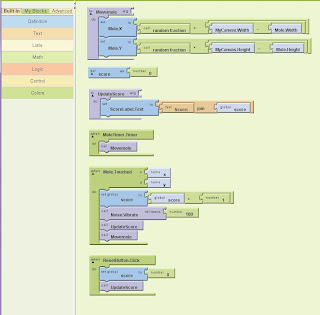Introduction (Purpose):
(Replace this with: what is the
purpose or problem that the program is trying to solve)
The purpose of this game is to entertain a child from around the ages of 10
and up. It is a fairly simple game that uses the arrow keys as a form of
movement of the sprite and requires a simple form of co ordination to be able
to guide the sprite to the appropriate coloured ball on the screen while
avoiding the ‘bad’ sprites that take away the lives of your sprite. The
instructions at the beginning of the screen guides the player through the
appropriate way to play the game and which way ensures successful completion of
the game.
Algorithm Outlining the Program:
(put
your flow chart here)
Explanation of Data Types used
(What types are used
in the variables in your program and where ?)
Text:
-Game over: sprites on the screen say ‘Game Over’ if all the lives are lost
before you manage to get all the coloured balls.
Integer:
-Progress score: determines if the player can advance to the next
level. The progress is unseen in the game and varies from numbers of -5 till
15.
-Score: This data
is seen on the screen. It increases in incriminates of 5 each time a coloured
ball is touched by the cat sprite.
-Lives: this data begins at 10 and decreases each time
the cat sprite is touched by another creature on the screen. When the lives
reach zero the sprites say ‘game over’ and
Control Structure examples
(copy and paste the
appropriate section from your program and explain)
Sequence:
In this sequence the
score and the progress can only occur once something else has already been
done. For example, in order for the progress to change by -5 the sprite has to
be touching the colour orange. If it is not touching the colour orange then the
commands under the ‘if’ bracket cannot be fulfilled and therefore the score
cannot be updated and the game will not progress.
Selection:
In this selection control
structure the coloured ball that is yellow is hidden when the green flag is
initially pressed to start the game. It then has to wait until the progress has
reached a certain number (zero) before it can then be show. If the right
progress number has not been selected then the yellow coloured ball will remain hidden
and the game can no longer continue.
Repetition:
In this control
structure the prompts in the ‘forever’ bracket will be constantly repeating.
This shows that if the sprite is to be moving around the screen randomly. If
the sprite comes to the edge of the screen it turns around in a random degree
generated by the game and kept moving forward. This process has to be
constantly repeating otherwise all the characters on the screen would stop
moving once they reached the edge of the screen.
Use of Error Detection
(explain how your
program handles incorrect user inputs)
In my game there are not any ways of causing an error in the
game. As my game only relies on hand-eye coordination and the ability to get
the colour balls in a particular order there isn’t much ways to cause an error.
The only real way to cause an error is if the user were to collect the coloured
balls in the incorrect order, but then the game automatically responds to this
sequence as incorrect and shows the ‘you lose’ image to indicate to the user
that what they have done is incorrect and they can no longer progress.
Also in my game, if the user were to manually pick up the sprite and move it to
the areas where the coloured balls are located, the computer does not recognise
the gamer as moving the sprite and therefore the ability to ‘touch’ the
coloured ball is taken away and the user cannot play the game correctly.
The only possible way to cheat in my game is if the user were to move the
sprite fairly close to the coloured ball, then use the arrow keys to ‘touch’
the coloured ball then they can progress forward. The only way to avoid this is
by putting the game on full screen, but this cannot be done automatically, so
the possibility of cheating still exists where the computer has to way of
identifying this error.




















